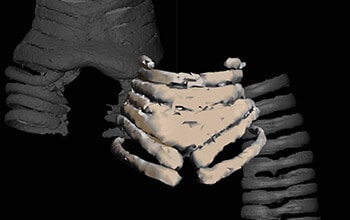The oldest-known vocal organ of a bird has been found in an Antarctic fossil that is related to ducks and geese and lived during the age of the dinosaurs, more than 66 million years ago.
The discovery of the Mesozoic Era vocal organ — called a syrinx — and its apparent absence in non-avian dinosaur fossils of the same age indicates that the organ may have originated late in the evolution of birds, and that other dinosaurs may not have been able to make noises similar to the bird calls we hear today. The findings were published today in the journal Nature.
Birds are direct descendants of dinosaurs and considered “living dinosaurs” by scientists.
“This finding helps explain why no such organ has been preserved in a non-bird dinosaur or crocodile relative,” said Julia Clarke, a paleontologist at The University of Texas at Austin’s Jackson School of Geosciences. Clarke, whose research is funded by the National Science Foundation (NSF), discovered the fossil syrinx and led the analysis. “This is another important step to figuring out what dinosaurs sounded like as well as giving us insight into the evolution of birds.”
The research was funded in part by NSF’s Division of Polar Programs and Division of Earth Sciences. Funding was also provided by Argentina’s Agencia Nacional de Promocion Cientifica y Tecnologica and the Gordon and Betty Moore Foundation.
Through its Division of Polar Programs, NSF manages the United States Antarctic Program, which manages almost all U.S. research on the southernmost continent.
The syrinx is made of stiff cartilage rings supporting soft tissues that vibrate to produce the complex songs and calls of modern birds. Cartilage does not fossilize as well as hard tissues, such as bone. But the high mineral content in the syrinx’s rings sometimes allows for fossilization. All other known examples of fossilized syrinxes occur in birds that lived long after non-avian dinosaurs went extinct.
The syrinx in question was discovered in a fossil of Vegavis iaai, a bird that lived during the Cretaceous period. In 2005, Clarke described the species, which was discovered on Antarctica’s Vega Island 13 years earlier by a team from the Argentine Antarctic Institute. However, it wasn’t until 2013 that Clarke noticed that the Vegavis fossil included a syrinx. During the past two years, the team searched the dinosaur fossil record for other examples of a syrinx. Thus far, they have found none.
The asymmetrical shape of the syrinx indicates that the Vegavis could have made honking noises via sound sources in the right and left parts of the organ. The researchers also scanned syrinxes of other birds to compare to the Vegavis syrinx.
Franz Goller, a co-author and physiologist at the University of Utah, said the study is the beginning of the work to determine what the fossilized organ can tell us about the sounds of early birds.
“Here, we begin to outline how fossilizable characteristics of the syrinx may inform us about sound features, but we need a lot more data on living birds,” Goller said. “Remarkably, prior to this work, there is almost no discussion of these important questions.”
This study follows research that Clarke and other collaborators published in July, 2016, which found that some dinosaurs would likely have made closed-mouth vocalizations akin to ostrich booms, which don’t require a syrinx. Together, the two studies have major implications for dinosaur sound-making, Clarke said.
“To speculate wildly, we might have closed-mouth booms more similar to crocodilians in large-bodied dinosaurs like T. rex,” Clarke said. “But in the late Cretaceous, the sounds of the forest would be more diverse, possibly with the higher pitched calls of modern bird relatives.”
In addition, the evolution of vocal behavior can provide insights into other anatomical features, Clarke said, such as the development of bigger brains.
“The origin of birds is about so much more than the evolution of flight and feathers,” Clarke said.
To study sound production in more detail, part of the team is working with engineers to model sound-producing organs, a project funded by the Gordon and Betty Moore Foundation.
Other collaborators on the most recent study include Zhiheng Li of the Chinese Academy of Sciences, Key Laboratory in Paleontology and Paleoanthropology; Tobias Riede of Midwestern University in Arizona; Sankar Chatterjee of Texas Tech University; and Fernando Novas and Federico Agnolin of the Museo Nacional Berandino Rividavia.
If our reporting has informed or inspired you, please consider making a donation. Every contribution, no matter the size, empowers us to continue delivering accurate, engaging, and trustworthy science and medical news. Independent journalism requires time, effort, and resources—your support ensures we can keep uncovering the stories that matter most to you.
Join us in making knowledge accessible and impactful. Thank you for standing with us!


Was there not a scene in Jurassic Park where they used a dinosaurs voice box (or something) to make music.